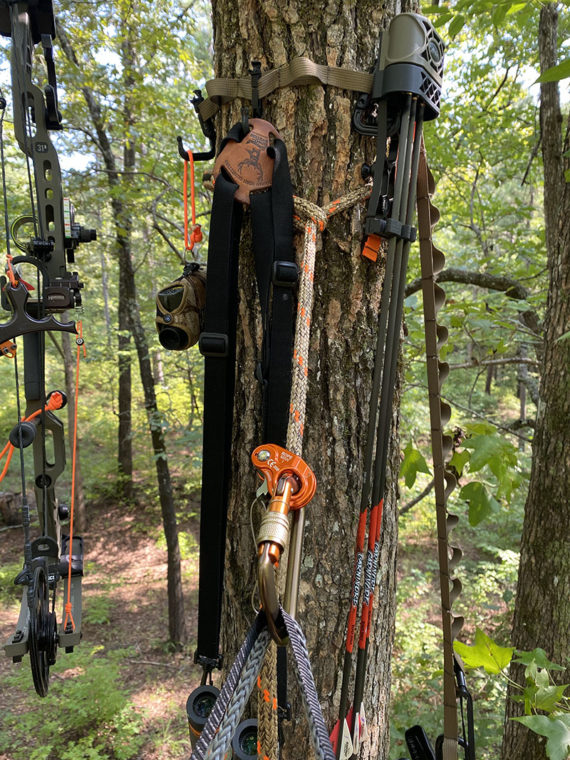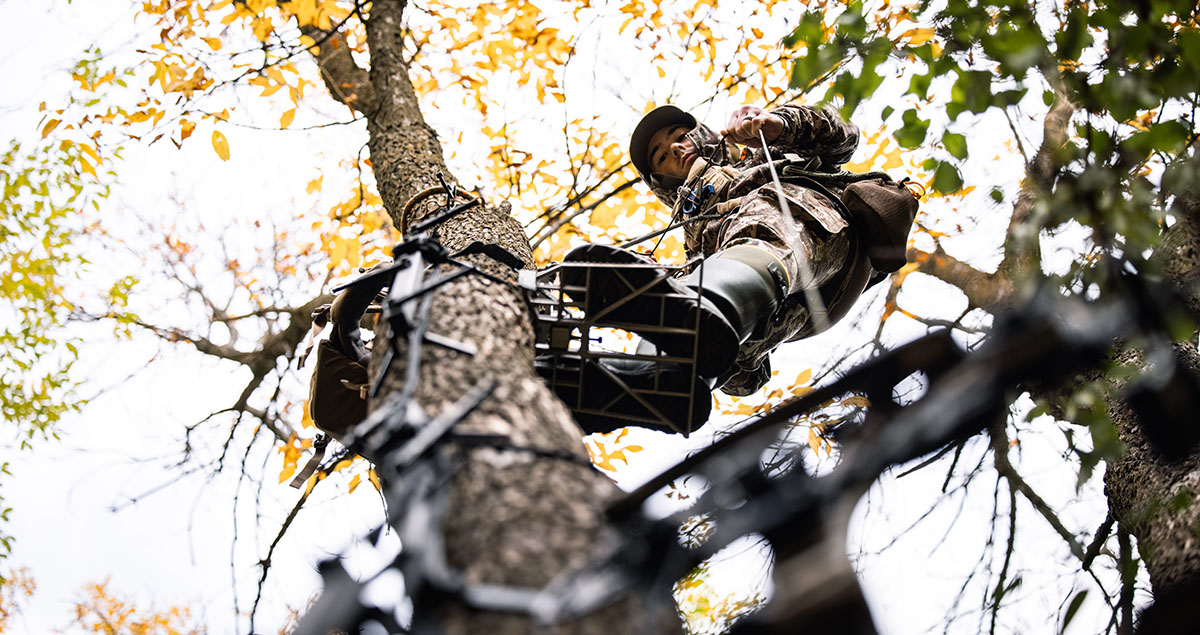Unless you’ve been unplugged from the online hunting community for the last few years, you’ve probably heard the buzz about saddle hunting. You may have even given it a try. While using a tree saddle to hunt deer is certainly not a new idea, it’s one that has exploded in popularity recently, particularly among public land hunters seeking to be as light and mobile as possible.
As someone who primarily hunts public land myself, the light weight and mobility certainly appealed to me. I don’t mind getting deep into public land to get away from the crowds, but at 49 years old, those longer treks with a back full of gear takes more of a toll on me with each passing season. Like many of you, though, I had my doubts on whether saddle hunting was the answer to my aging body’s aches and pains.
My first thoughts when I started seeing the saddle hunting craze fill my social media feeds was, “that can’t be comfortable,” with a side of “that doesn’t seem safe.” However, everyone I encountered who had tried saddle hunting seemed to love it. With that in mind, I picked up my first saddle hunting setup from Tethrd last summer with the thought that I can always sell it if it doesn’t work out.
There was some confusion early on as far as what equipment I really needed to get started saddle hunting, and what equipment could wait. I wrote an article on that topic last September.
RELATED: Everything You Need to Give Saddle Hunting a Try
Now, as I sit here with my first deer season from the saddle under my belt, I can reflect on how it went and what I learned along the way. Hopefully this can help some of you who may be on the fence about saddle hunting decide whether it’s right for you.
It Takes Getting Used To
Saddle hunting is a whole new ballgame compared to hunting from a tree stand, so don’t expect to immediately be comfortable in the saddle. Fortunately I got mine well before Georgia’s deer season opened, which gave me plenty of time to practice climbing trees and getting setup in my back yard. If you’re used to using climbing sticks and a hang-on stand, that part won’t be too difficult for you. It’s basically the same procedure, only your platform is likely much smaller when saddle hunting, and once you’re up the tree and on your platform, you’re facing the tree.

One of the biggest adjustments to saddle hunting is figuring out how to arrange your gear so it’s readily available, but not in your way.
The real adjustment comes in learning how to position yourself to stay comfortable, how to position your gear so it’s easy to access but not in the way, and how to maneuver yourself for various shot opportunities. My initial tests in the yard went well, and I was impressed with how comfortable it was (at least in short bouts), and how freeing it felt. Don’t get me wrong, that first time in the tree, it wasn’t easy to put all my trust in the tether and lean away from the tree 15 feet or so in the air. Once you do, though, and realize there is no way you’re going to fall, it is a very freeing feeling.
Another aspect of saddle hunting that takes some adjustment is the setup — both how to set up in the tree based on where you expect deer to come from and how to set up all your gear in the tree so you can access it when needed, but it’s not in the way. Again, this is a whole different ball game than normal tree stand hunting because you are facing the tree rather than facing away from it, and you want to try to position yourself so the deer pass by on your strong side (left side for right-handed shooters and the right side of left-handed shooters). More on that a little later.
The good news is that you’ll quickly overcome these initial challenges once you start hunting from a saddle. It’s going to be awkward for the first few hunts, but you’ll quickly adjust. One of the best things I did was head to my local wildlife management area prior to opening day for an observation sit to work out the kinks in the setup procedure and to see how I felt spending a few hours in the saddle.
Saddle Hunting is Comfortable
I’m not going to lie to you. About an hour into that first sit, I started second guessing whether I’d be hunting from a saddle that season. I was getting a little restless and starting to have some discomfort in my hips. That led me to start experimenting with different positions in the tree. There are a numerous ways you can position yourself while saddle hunting centered around two broad styles — leaning or sitting. I’m primarily a leaner, meaning for most of the hunt I am in a standing position, leaning back away from the tree. Others prefer to sit in their saddle like you would sit in a swing with their knees against the tree. If you’re going to sit, you’ll definitely want to invest in knee pads or a pad to strap to the tree to protect your knees.
While I’m primarily a leaner, I’ll switch between leaning and sitting as needed to stay comfortable – similar to how I would switch between sitting and standing in a climber or hang on. By the end of my first long sit, I was feeling much better about saddle hunting and being able to stay comfortable. You’ll often hear people refer to getting in “saddle shape” when you first begin saddle hunting. They’re referring to that process of getting your body adjusted to this new style of hunting. It’s a real thing, so just be prepared to give yourself a few hunts to really make a decision on whether saddle hunting is something you want to keep doing.
Saddle Hunting is Safe
As far as the safety issue, saddle hunting is as safe or safer than any other style of elevated hunting. That’s because, when done properly, the saddle hunter is connected to the tree 100% of the time. The only way you could fall to the ground is if your tether rope or saddle broke, and since you’re using the same type of gear rock climbers and arborists use, the likelihood of catastrophic equipment failure is extremely small.
Saddle Hunting Has Limitations
Despite all the benefits of hunting from a saddle, it does have its limitations. I quickly learned that last November while deer hunting public land in Kentucky. Just before dark a decent buck made his way in from directly behind me. I assumed he was going to follow the same path as the previous yearling buck and walk by my left side, giving me a perfect 10-yard broadside shot. As it often happens, though, the buck had other plans. After stopping 20 yards out, directly behind me, to assess his surroundings, he broke to his right. I immediately spun 180 degrees counterclockwise to try to get a shot at the six o’clock position. And that may have worked, except he was already walking at a steady pace by the time my 20-yard pin reached the crease behind his shoulder. I briefly continued to follow his vitals with my pin until I couldn’t rotate any further. My only option at that point was to spin nearly 360 degrees in the opposite direction to try to get back on him. By the time I was able to make that turn and get my bow and arrow up and around the tree I was in, it was too late. The buck had already made his way below me into thick cover, still walking at a steady pace. Game over.
Now don’t get me wrong. It wasn’t the saddle’s fault I blew that hunt. I made an incorrect assumption about what that buck was going to do, and it cost me the shot. But it did open my eyes to the limitations of saddle hunting, and how tough it can be to make a weak-side shot.
Saddle hunting also has limitations when hunting with a firearm or crossbow. If a deer comes in from in front of you, then the tree you’re facing can make a great rest to help steady your weapon for the shot. However, if the deer don’t follow the script and they come in from a different direction, you’re left trying to make a free-hand shot. This differs from most deer stands, which typically provide a better means of steadying a gun or crossbow for the shot.
Summary
Overall, my first year hunting from a saddle was a good one. I learned a lot, and each hunt became a little easier and more enjoyable. While I may still occasionally use a climber when and where it makes sense, most hunts this deer season will find me “back in the saddle,” leaned back just enjoying everything nature has to offer.
